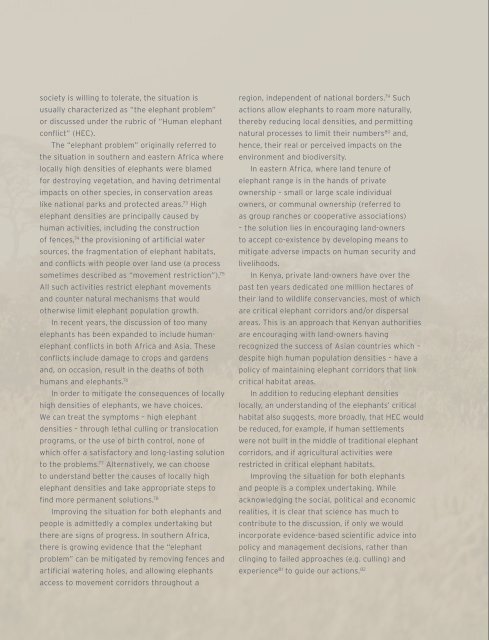ELEPHANTS & IVORY
ELEPHANTS & IVORY
ELEPHANTS & IVORY
Create successful ePaper yourself
Turn your PDF publications into a flip-book with our unique Google optimized e-Paper software.
society is willing to tolerate, the situation is<br />
usually characterized as “the elephant problem”<br />
or discussed under the rubric of “Human elephant<br />
conflict” (HEC).<br />
The “elephant problem” originally referred to<br />
the situation in southern and eastern Africa where<br />
locally high densities of elephants were blamed<br />
for destroying vegetation, and having detrimental<br />
impacts on other species, in conservation areas<br />
like national parks and protected areas. 73 High<br />
elephant densities are principally caused by<br />
human activities, including the construction<br />
of fences, 74 the provisioning of artificial water<br />
sources, the fragmentation of elephant habitats,<br />
and conflicts with people over land use (a process<br />
sometimes described as “movement restriction”). 75<br />
All such activities restrict elephant movements<br />
and counter natural mechanisms that would<br />
otherwise limit elephant population growth.<br />
In recent years, the discussion of too many<br />
elephants has been expanded to include human-<br />
elephant conflicts in both Africa and Asia. These<br />
conflicts include damage to crops and gardens<br />
and, on occasion, result in the deaths of both<br />
humans and elephants. 76<br />
In order to mitigate the consequences of locally<br />
high densities of elephants, we have choices.<br />
We can treat the symptoms – high elephant<br />
densities – through lethal culling or translocation<br />
programs, or the use of birth control, none of<br />
which offer a satisfactory and long-lasting solution<br />
to the problems. 77 Alternatively, we can choose<br />
to understand better the causes of locally high<br />
elephant densities and take appropriate steps to<br />
find more permanent solutions. 78<br />
Improving the situation for both elephants and<br />
people is admittedly a complex undertaking but<br />
there are signs of progress. In southern Africa,<br />
there is growing evidence that the “elephant<br />
problem” can be mitigated by removing fences and<br />
artificial watering holes, and allowing elephants<br />
access to movement corridors throughout a<br />
region, independent of national borders. 79 Such<br />
actions allow elephants to roam more naturally,<br />
thereby reducing local densities, and permitting<br />
natural processes to limit their numbers 80 and,<br />
hence, their real or perceived impacts on the<br />
environment and biodiversity.<br />
In eastern Africa, where land tenure of<br />
elephant range is in the hands of private<br />
ownership – small or large scale individual<br />
owners, or communal ownership (referred to<br />
as group ranches or cooperative associations)<br />
– the solution lies in encouraging land-owners<br />
to accept co-existence by developing means to<br />
mitigate adverse impacts on human security and<br />
livelihoods.<br />
In Kenya, private land-owners have over the<br />
past ten years dedicated one million hectares of<br />
their land to wildlife conservancies, most of which<br />
are critical elephant corridors and/or dispersal<br />
areas. This is an approach that Kenyan authorities<br />
are encouraging with land-owners having<br />
recognized the success of Asian countries which –<br />
despite high human population densities – have a<br />
policy of maintaining elephant corridors that link<br />
critical habitat areas.<br />
In addition to reducing elephant densities<br />
locally, an understanding of the elephants’ critical<br />
habitat also suggests, more broadly, that HEC would<br />
be reduced, for example, if human settlements<br />
were not built in the middle of traditional elephant<br />
corridors, and if agricultural activities were<br />
restricted in critical elephant habitats.<br />
Improving the situation for both elephants<br />
and people is a complex undertaking. While<br />
acknowledging the social, political and economic<br />
realities, it is clear that science has much to<br />
contribute to the discussion, if only we would<br />
incorporate evidence-based scientific advice into<br />
policy and management decisions, rather than<br />
clinging to failed approaches (e.g. culling) and<br />
experience 81 to guide our actions. 82<br />
51<br />
© IFAW/D. Willetts/Tsavo National Park, Kenya


